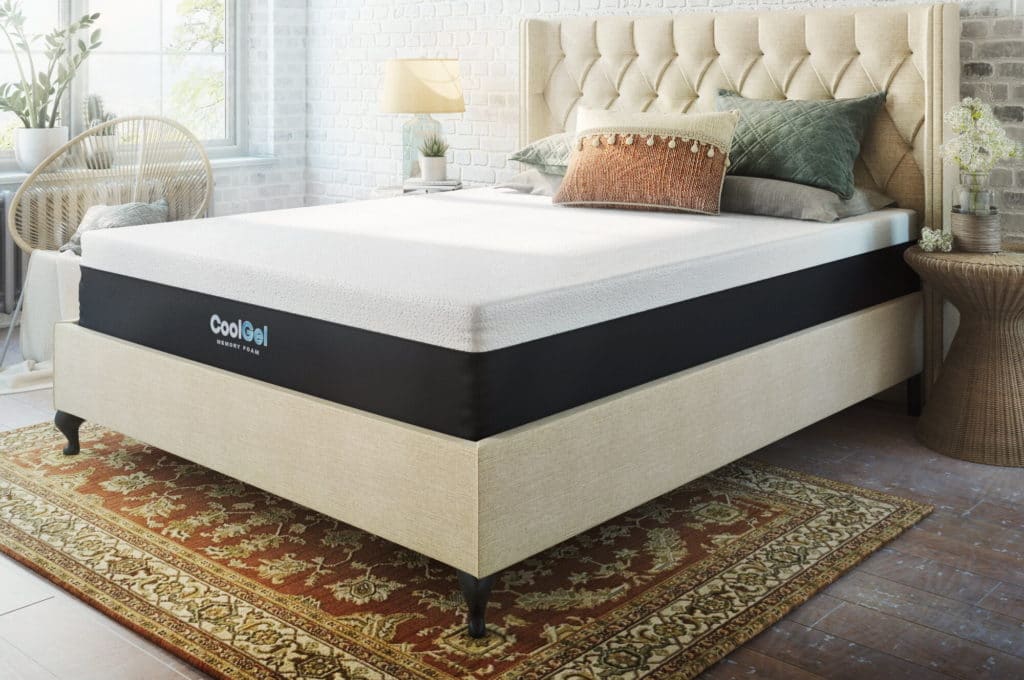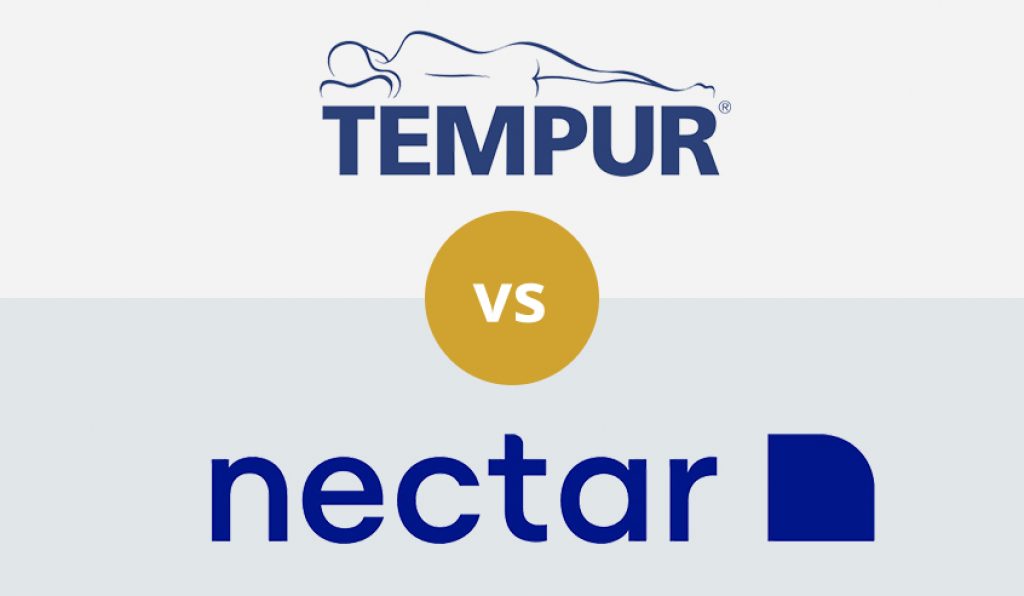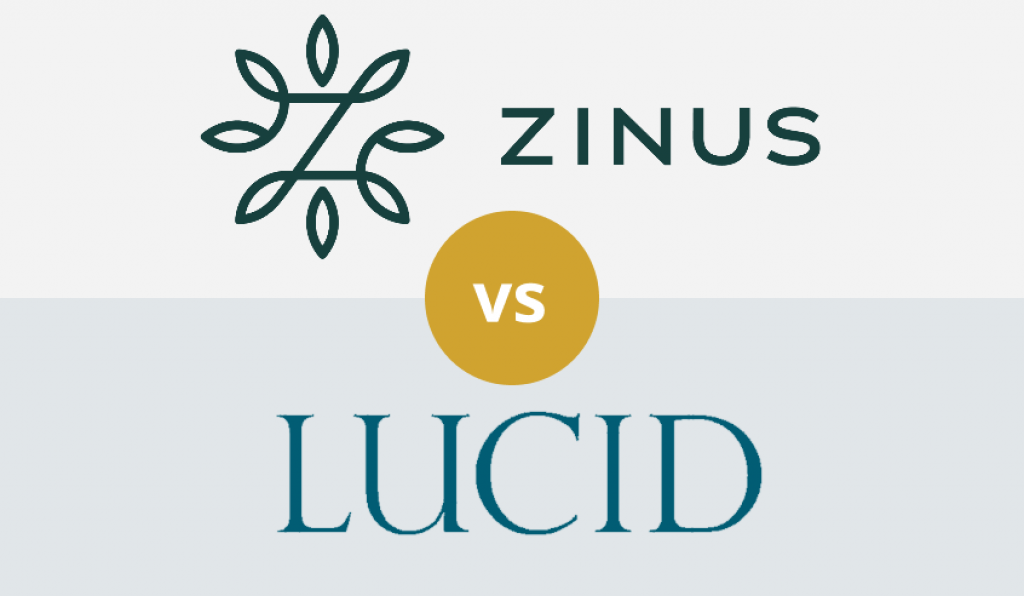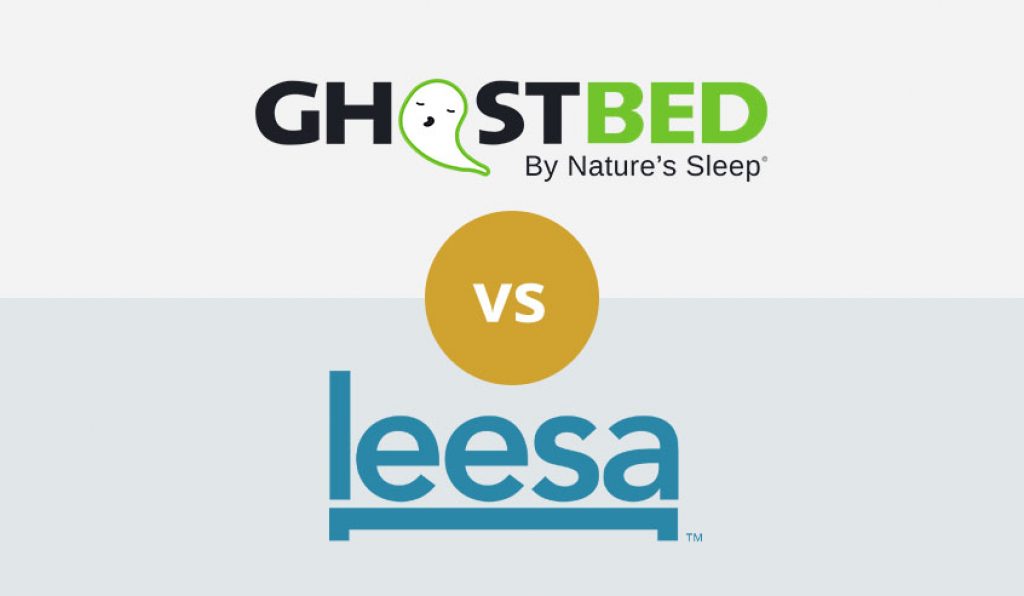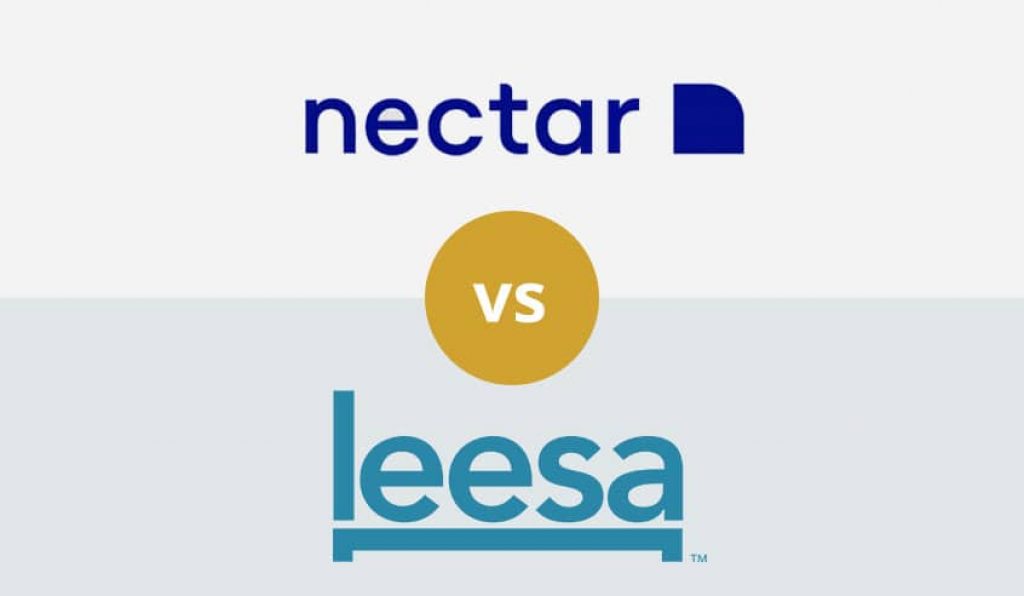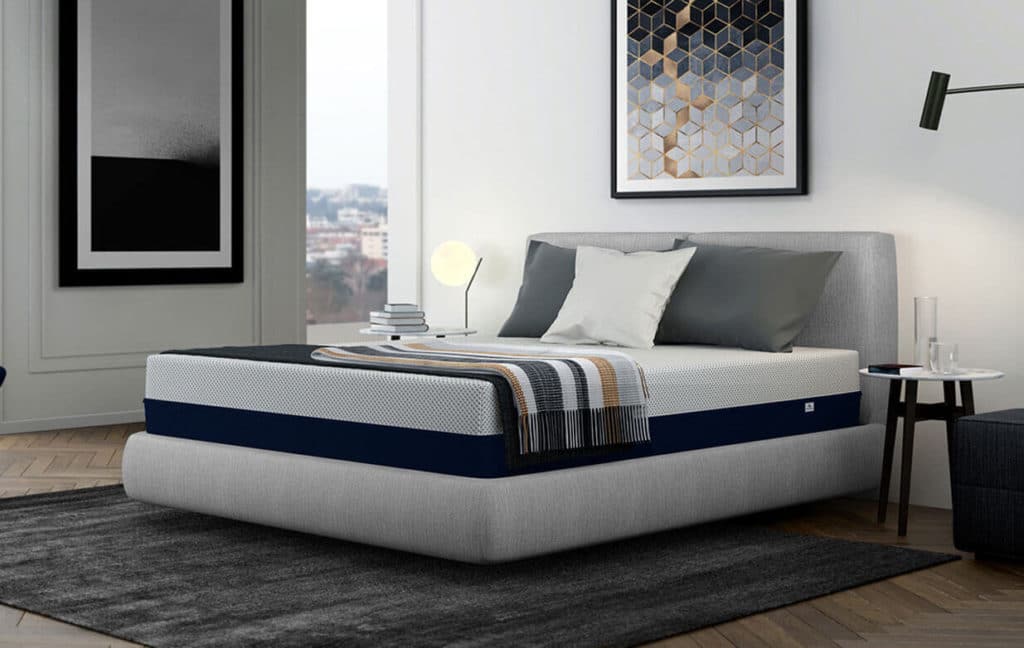

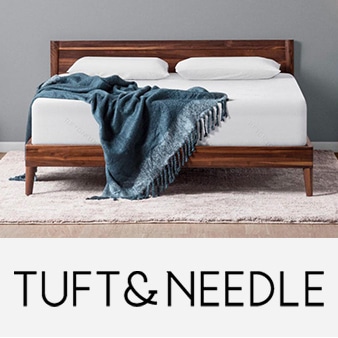
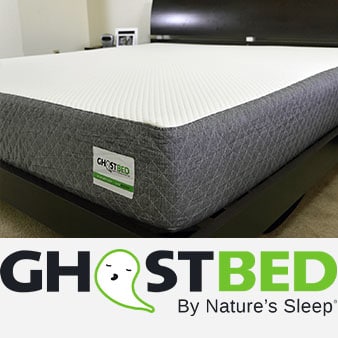
Getting a good night’s sleep is easier than ever thanks to the recent proliferation of bed-in-a-box mattresses. Today, we’ll take a closer look at the Tuft & Needle vs GhostBed mattresses, two of the most popular and affordable beds available for anyone in need of a sleeping upgrade. These two foam mattresses are very similar in firmness and price, allowing them to appeal to people with the same sleeping style. However, the construction of the two mattresses differs quite a bit, which can dramatically change the comfort of the beds for different people. With that in mind, we’ll look closely at the features that differentiate these mattresses and explain how they can affect your sleep.
Tuft & Needle first introduced their mattress in 2012 and it has been a huge success with people looking to upgrade their mattress while keeping to a budget ever since. The mattress is rated as medium firm (6.5 on a scale of 10) and is made completely of adaptive foam. Unlike memory foam, adaptive foam stays cool throughout the night and offers enough support to keep you on top of the mattress rather than sinking into it. Tuft & Needle offers a 10-year warranty and a 100-night sleep trial so you can feel confident trying out and committing to the mattress.
The GhostBed is a relatively newer mattress, introduced in 2015 as a direct competitor to the Tuft & Needle mattress. It too is rated as 6.5 out of 10 in firmness, but is constructed with layers of synthetic latex and gel-infused memory foam that give it a very different feel. The latex provides more bounce than adaptive foam, while the gel-infused memory foam allows sleepers to sink in slightly while also maintaining cool temperatures throughout the night. The GhostBed mattress is somewhat more expensive than the Tuft & Needle mattress, but comes with a 20-year warranty in addition to a 101-night sleep trial.
| Tuft & Needle | GhostBed |
|
|
| VIEW ON AMAZON | VIEW ON AMAZON |
| Tuft & Needle | GhostBed | |
| Type | Foam | Foam |
| Firmness | Medium firm (6.5) | Medium Firm (6.5) |
| Thickness | 10″ | 11″ |
| Weight | 71 lbs | 89 lbs |
| Sleep trial | 100 nights | 101 nights |
| Warranty | 10 years | 20 years |
| Price | $595 (Queen) | $895 (Queen) |
| Certification | Greenguard Gold Standard 100 by OEKO-TEX Certi-PUR-US |
Certi-PUR-US |
| Tuft & Needle | GhostBed | |
| Support core | 7″ 1.8 PCF HD polyfoam | 7 1/2″ 2 PCF HD Polyfoam |
| Comfort layers | 3″ 2.8 PCF polyfoam | 1 1/2″ Synthetic Dunlop Latex 2″ 4 PCF Gel Memory Foam |
| Cover | Micro polyamide and polyester | Viscose/Polyester Blend |
The support core of the Tuft & Needle and GhostBed mattresses is nearly identical, constructed from PCF high-density polyfoam. Note that the GhostBed support core is slightly thicker and uses even higher-density foam, potentially making this mattress slightly more comfortable for heavyset sleepers.
Where the two mattresses really diverge is in the comfort layers. The Tuft & Needle mattress uses a three-inch layer of adaptive foam, which gives very little when you lie down in the mattress. Instead, adaptive foam allows you to float comfortably on top of the mattress with just enough softness to prevent pressure points from developing. Altogether, this firmness makes it well-liked among back, stomach, and side sleepers. Better yet, Tuft & Needle’s adaptive foam is infused with gel and graphite so it does an excellent job of transferring heat away from your body.
The GhostBed mattress, on the other hand, is built with a lower layer of synthetic latex and an upper layer of gel-infused memory foam. The latex layer is designed to create a firm, but comfortable and springy base between the memory foam and the support core. That way, side sleepers and heavyset sleepers won’t find themselves sinking through to the overly firm and often uncomfortable support core as the memory foam settles around their bodies. However, keep in mind that latex can also cause allergies for some users.
The gel-infused memory foam layer is significantly softer than Tuft & Needle’s adaptive foam, allowing your body to sink a few inches into the mattress when you lie down. Unlike traditional memory foam, GhostBed’s gel-infused memory foam is designed to enhance heat transfer away from your body so you won’t overheat in the middle of the night. While gel-infused memory foam is typically less durable than standard memory foam, this concern is somewhat alleviated by GhostBed’s 20-year full-refund warranty.
The comfort of a bed ultimately comes down to personal preference, although there are a number of features that can indicate whether a mattress will be more or less comfortable for your style of sleeping. These include not only the firmness of a mattress, but also how well it is able to transfer heat, respond to your movements, and move heat away from your body.
In general, both the Tuft & Needle and GhostBed mattresses are comfortable for back, side, and stomach sleeping. However, the Tuft & Needle mattress will appeal to sleepers who prefer to float on top of the mattress, while the GhostBed mattress will appeal to sleepers who prefer the sinking and supportive feeling of memory foam.
The Tuft & Needle and GhostBed are both rated a 6.5 out of 10 in terms of firmness, although this rating does not reflect the feel of lying down on the two mattresses. When lying down onto the Tuft & Needle mattress, you can expect that the mattress won’t sink – the adaptive foam is soft enough to compress, but your body will be supported as if floating on top of the mattress. Keep in mind that if you need the mattress to support concavities around your back, neck, or hips, the Tuft & Needle mattress will not expand or compress to meet those concavities.
When you lie down on the GhostBed mattress, on the other hand, the memory foam will compress significantly and continue compressing for several minutes. This gives a feeling of sinking into the mattress and allows the memory foam to meet and fill and concavities around your body, making it ideal for sleepers with back or hip pain. Keep in mind that the presence of the latex layer on the GhostBed mattress means that you won’t sink into the mattress as much as on a standard memory foam mattress.
One of the major advantages of the Tuft & Needle mattress compared to most memory foam mattresses is that it does not suffer from the same issue of heat buildup during the night. Sleepers don’t sink into the mattress, so from the start you are not surrounded by heat-trapping foam. In addition, Tuft & Needle’s adaptive foam is infused with gel and graphite to enhance the transfer of any heat that the mattress does capture away from your body.
Since the GhostBed uses a memory foam layer for comfort, it cannot boast quite the same level of heat dissipation as the Tuft & Needle mattress. However, the GhostBed is far superior to many other memory foam mattresses because the memory foam is infused with gel and because of the latex layer below the foam. The gel in the memory foam enhances heat transfer away from your body, and the latex layer is much more effective at conducting heat than the foam. This is a particular advantage for heavyset sleepers who will come closer into contact with the latex layer.
Both the Tuft & Needle and GhostBed mattresses do an excellent job of preventing motion from transferring across the bed. This can be very important if you have a partner who tosses and turns or who goes to sleep or wakes up at a different time than you, since their motion in the bed could wake you up. The GhostBed is slightly superior to the Tuft & Needle mattress in this category thanks to the memory foam and latex layers, which are both highly effective at dampening motion.
Responsiveness is often at odds with reducing motion transfer, but that’s not the case with the GhostBed thanks to the latex layer beneath the memory foam. In fact, the GhostBed is slightly more responsive than the Tuft & Needle mattress, even though the adaptive foam is much less compressible than memory foam. The latex layer in the GhostBed provides excellent bounce and gives sleepers a surface to push against after the memory foam has conformed to your body.
The Tuft & Needle and GhostBed mattresses are very comparable when it comes to resilience and bounce. The adaptive foam in the Tuft & Needle doesn’t compress much in the first place, so sleepers report very few issues with it bouncing back to its original shape within a minute of getting out of the bed. The memory foam in the GhostBed mattress takes longer to bounce back to its original form, but the foam is highly durable and the latex layer beneath provides a bottom point for how far the memory foam can compress when sleeping.
The latex layer of the GhostBed mattress allows this mattress to exceed the Tuft & Needle in terms of edge support as well. While you’ll have to wait for the memory foam to compress a few inches before the support kicks in, the latex layer is very firm and will not give at the edge like any foam material.
That’s not to say the Tuft & Needle mattress lacks edge support, though – the adaptive foam is relatively sturdy at the edge. However, since the foam will compress slightly, you’ll need to be slightly more careful of rolling off at the edge of the mattress.
Both the Tuft & Needle and GhostBed are quick to inflate and have very little chemical smell from off-gassing upon arrival. Although the manufacturers of each bed recommend allowing two to three days for the mattresses to fully inflate and off-gas, users report that they are typically ready to sleep on by the evening of the day they arrive.
| SLEEP POSITION | Light sleepers (less than 130 lbs) |
Average sleepers (130 lbs to 230 lbs) |
Heavy sleepers(greater than 230 lbs) |
| Tuft & Needle | |||
| Side | 6 | 8 | 6 |
| Back | 8 | 7 | 8 |
| Stomach | 6 | 7 | 7 |
| GhostBed | |||
| Side | 7 | 7 | 7 |
| Back | 8 | 9 | 8 |
| Stomach | 6 | 7 | 6* |
*Out of 10
The Tuft & Needle and GhostBed mattresses are designed to appeal to a wide array of people, including side, back, and stomach sleepers. The Tuft & Needle mattress is best for sleepers who prefer to float on top of the bed rather than sink into it and who do not have concavities around their backs or hips that need to be supported. The GhostBed is better for people who suffer from back or hip pain since the memory foam will conform to give support around these areas. While the latex layer in the GhostBed can make it a better choice for some heavyset sleepers, the adaptive foam in the Tuft & Needle mattress is also relatively comfortable for many heavier sleepers.
| SIZE | Tuft & Needle | GhostBed |
| Twin | $350 | $445 |
| Twin XL | $395 | $645 |
| Full | $495 | $820 |
| Queen | $595 | $895 |
| King | $750 | $1,075 |
| California King | $750 | $1,095 |
| Split King | N/A | $1,290 |
| Sleep trial | Warranty and refund | Delivery | |
| Tuft & Needle | 100 nights | 10-year warranty full refund |
Within the U.S. |
| GhostBed | 101 nights | 20-year warrantyfull refund | Within the U.S. |
Both Tuft & Needle and GhostBed offer generous sleep trials and warranties on their mattresses to give you confidence in trying and committing to their beds. The 100-night sleep trials are truly trials – if you decide you do not like the bed at the end of the trial period, Tuft & Needle and GhostBed will work with you to return to the mattress to a local donation center or to a local mattress retailer.
When it comes to the warranty periods, it’s worth noting that the difference between 10 and 20 years is quite large. This is especially noteworthy when considering that the GhostBed uses gel-infused memory foam, which has a tendency to remain compressed after years of use. However, the warranties of both mattresses ensure that compression of the foam is covered.
Keep in mind that neither Tuft & Needle nor GhostBed have been making mattresses for the length of their warranty periods, so it’s as yet not possible to comment on the long-term durability of the mattresses. However, users report that the Tuft & Needle mattress has held up well after seven years and the GhostBed has not experienced issues after four years.
Pros
Cons
Pros
Cons
The Tuft and Needle and GhostBed mattresses are each an excellent choice for an extremely wide variety of sleepers. The Tuft & Needle mattress will appeal most to people who don’t like the sinking feeling of memory foam, preferring instead to float on top of the mattress. On the other hand, the GhostBed provides more cushioning for sleepers who suffer from back or hip pain. Another important difference between the Tuft & Needle vs GhostBed mattresses is that the Tuft & Needle mattress offers better heat transfer away from your body to keep you cool. While the GhostBed is slightly more expensive, it comes with a warranty that is twice as long – and the higher price can be well worth it for sleepers who find the GhostBed to be more comfortable.
